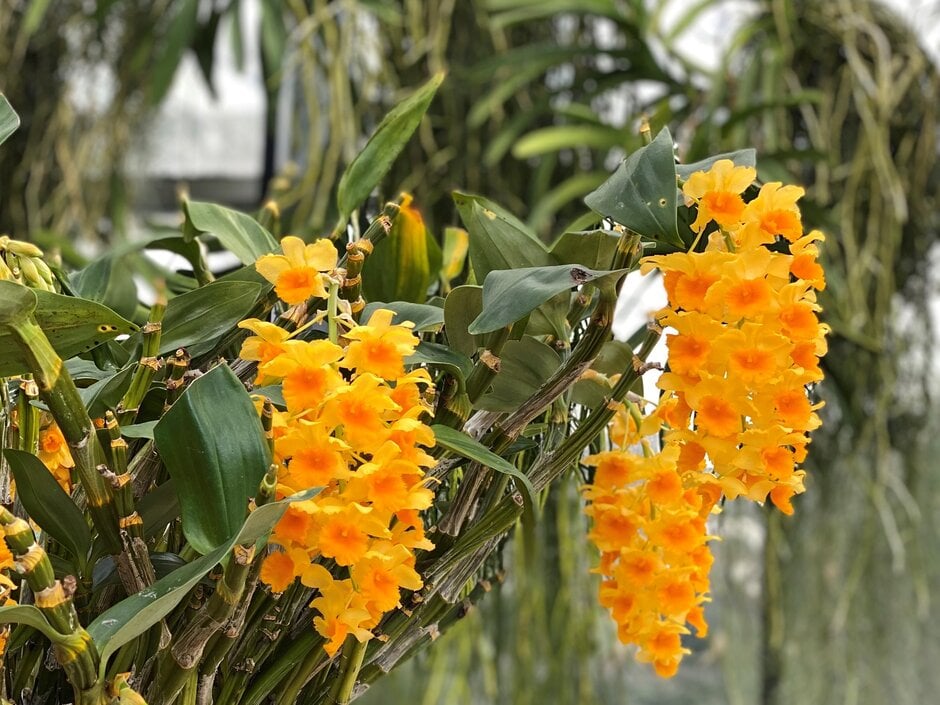Dendrobium densiflorum
pineapple orchid
A medium-sized, evergreen, epiphytic orchid with cane-like, fleshy, green upright pseudobulbs up to 60cm long. Four to six dark green, leathery, glossy leaves are arranged along the upper nodes and near the top of each pseudobulb. Each lance-shaped leaf is 10-15cm long and 6-7cm wide. Pendant, densely-flowered racemes emerge from the axils of leaves in winter and spring. Short-lived flowers are bright yellow, 5cm large with rounded lip with darker yellow-orange centre.
Size
Ultimate height
0.5–1 metresTime to ultimate height
5–10 yearsUltimate spread
0.5–1 metresGrowing conditions
Moisture
Well–drainedpH
NeutralColour & scent
| Stem | Flower | Foliage | Fruit | |
| Spring | Green Grey Silver | Yellow Orange | Green | |
|---|---|---|---|---|
| Summer | Green Grey Silver | Green | ||
| Autumn | Green Grey Silver | Green | ||
| Winter | Green Grey Silver | Yellow Orange | Green |
Position
- Full sun
- Partial shade
Aspect
East–facing or South–facing or West–facing
Exposure
Sheltered Hardiness
H1ABotanical details
- Family
- Orchidaceae
- Native to GB / Ireland
- No
- Foliage
- Evergreen or Semi evergreen
- Habit
- Clump forming, Columnar upright
- Genus
Dendrobium are epiphytic and terrestrial orchids with elongated, stem-like pseudobulbs bearing linear to ovate leaves. Racemes or panicles of showy flowers are produced from nodes along the stems mainly in spring
- Name status
Correct
- Plant range
- Himalaya to SE Asia & China
How to grow
Cultivation
Plants are best grown in a pot in an epiphytic, medium grade, bark-based potting mix with added perlite, moss, or coir. As with many orchids, they grow best when the roots are slightly restricted. Therefore, avoid over-potting or frequent root disturbance. It is a cool to warm-growing orchid with average temperatures between 16-25°C. It can be grown similarly to Moth Orchid (Phalaenopsis) but requires much brighter conditions. Provide indirect light and higher humidity by misting regularly in spring and summer, then move the plant to a bright, room in autumn and winter. Reduce watering and feeding until warmer temperatures initiate new growth in spring. See indoor orchid cultivation
Propagation
Propagation by seed is only possible in controlled laboratory environment. Mature plants may be divided when the plant overgrows the pot. Sideshoots (keiki) may develop on older canes - remove and pot them into sphagnum moss when the new roots are at least 2cm long.
Suggested planting locations and garden types
- Houseplants
- Conservatory and greenhouse
Pruning
No pruning required. Remove spent flowers as necessary, but do not cut the whole cane unless completely shrivelled. Oldest canes may be removed as long as there are enough, younger, thick, leaf-bearing canes on the plant.
Pests
May be susceptible to scale insects, aphids, mealybugs and red spider mite.
Diseases
Generally disease-free.
Love gardening
Sign up to receive regular gardening tips, inspiration, offers and more
View our Privacy Policy
Get involved
The Royal Horticultural Society is the UK’s leading gardening charity. We aim to enrich everyone’s life through plants, and make the UK a greener and more beautiful place.

